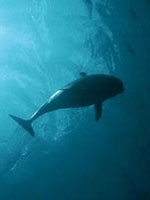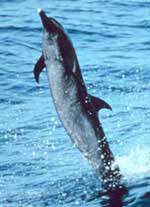Grist readers deserve better than the poorly informed coverage of the tuna/dolphin issue in a recent article by Rick Gaffney, which makes false and misleading claims about “dolphin safe” tuna fishing methods.

A dolphin in the deep.
Earth Island Institute, Defenders of Wildlife, the Humane Society of the United States, and dozens of other organizations have worked on the tuna/dolphin issue for more than a decade, and our successful efforts to reduce dolphin deaths in the Eastern Tropical Pacific tuna fishery by 97 percent is considered one of the signature accomplishments of the modern environmental movement. We all celebrated on Earth Day 1990 with the historic announcement by StarKist — the largest tuna company in the world — that it would no longer buy tuna caught by methods that harm dolphins. Today, 97.1 percent of the world’s tuna is caught without chasing and netting dolphins at all. There are ample supplies of tuna without resorting to this cruel and destructive fishing practice.
One cannot understand the battle to protect the “dolphin safe” tuna label without realizing that the World Trade Organization, and the wide-ranging corporate establishment that supports it, views this fight as a symbol of how to get rid of environmental laws that restrict trade of any product, no matter how it is produced or obtained. Mexican Pres. Ernesto Zedillo threw down the gauntlet, in a White House meeting in 1995 with Pres. Clinton and Vice Pres. Gore, when he demanded that the U.S. drop its tuna embargoes and get rid of the “dolphin safe” label or face an embarrassing international fight in the WTO. The Clinton administration had already made clear its intentions to let open trade take precedence over environmental protection.
Secret negotiating meetings were held in Washington, D.C., with the Mexican fisheries agency to produce the “Panama Declaration,” a laundry list of amendments to weaken the U.S. Marine Mammal Protection Act in exchange for an unverifiable international agreement allowing the killing of dolphins in the tuna fishery in perpetuity. Some deal! The resulting legislation was carried by notable congressional anti-environmentalists — Reps. Randy Cunningham (R-Calif.) and Don Young (R-Alaska) in the House and Sens. Ted Stevens (R-Alaska) and Frank Murkowski (R-Alaska) in the Senate. The bill was opposed by every pro-environment member of Congress who had ever been involved in crafting dolphin protection legislation.
While it is touted as an international dolphin conservation agreement, the deal in fact weakens dolphin protection by failing to provide any mechanism to reduce dolphin deaths in the tuna fishery to “levels approaching zero,” as U.S. law requires.
Instead, the agreement allows increased dolphin deaths — 5,000 per year, more than twice the actual dolphin kill in 1998 — and includes absolutely no requirement for any reduction in the dolphin death rate in the future. It ignores new scientific findings that dolphin populations are not recovering, despite low observed death rates in the nets. This suggests — not surprisingly — that the practice of repeatedly chasing and netting dolphins causes serious harm, even if dolphins are released.

I’m alive!
Photo: NOAA.
The new agreement legitimizes a Dolphin Mortality Limit (DML) quota for tuna vessels, with absolutely no incentives for the development of alternative fishing methods that don’t involve the chasing and netting of dolphins. Overall dolphin mortality could have been reduced by preventing the re-issuance of dolphin death certificates from vessels not killing their entire quota each year. Instead, vessel DML’s are allowed to be re-assigned, and traded, ensuring a higher level of dolphin killing.
The agreement is also totally unenforceable. The negotiating nations made sure that only individual nations can enforce any aspect of the agreement, leaving dolphin protection up to the mercy of government fishery bureaucracies. Efforts to deny DML’s to captains and vessels with long histories of serious violations, such as using explosives and intimidating international observers, were blocked. In fact, all specific recommended penalties and fines were deleted from the agreement.
Furthermore, the government of Mexico inserted language conditioning enforcement measures on the “national laws” of the nations, effectively stopping all enforcement in countries like Mexico, whose constitution prohibits large fines and forfeitures.
Gaffney’s article contains numerous factual errors and half-truths about the issue of bycatch in the tuna fishery. It claims that most “dolphin safe” tuna fishing is done by setting nets on floating objects, resulting in high bycatch. This is false. The vast proportion of “dolphin safe” tuna fishing around the world is done either by setting nets on schools of free-swimming tuna or by hook and line. Floating object net sets are relatively uncommon, constituting less than a quarter of all net sets in the Eastern Tropical Pacific tuna fishery in 1998 and less than 3 percent of the world catch.
The article also claims that saving dolphins leads to fishing practices that are destructive to non-target fish. In fact, the large foreign tuna fleets that set nets on dolphins also routinely set their nets on floating objects, when the opportunity is present, and they have done so for decades. Only with the success of our “dolphin safe” campaign have tuna fishing nations raised the red herring of nontarget fish losses in “dolphin safe” fishing practices.
Tellingly, there have been no efforts, either by the U.S. government or by the Inter-American Tropical Tuna Commission, to restrict net sets on logs or other floating objects, methods with the highest bycatch levels, by the massive fleets of Mexico, Venezuela, and Colombia. Once the “bycatch” issue successfully provided a green cast to the package of MMPA-weakening amendments in Congress, any meaningful efforts to reduce bycatch disappeared.
Our organizations have been in the forefront of efforts to protect the entire ocean ecosystems of the world, including whales and dolphins. Claims that our groups “focus on charismatic megafauna” are simplistic and disingenuous. The “dolphin safe” campaign, which includes a prohibition on the use of high seas drift nets, has made a major worldwide contribution to reducing bycatch and ridding the oceans of senselessly destructive fishing practices.
Every can of tuna which remains truly “dolphin safe” — i.e., caught without the deliberate chasing and netting of dolphins — is a benefit to the marine environment, and a testament to those who have fought for decades to protect dolphins and other marine life from destructive and senseless fishing practices the world over.

